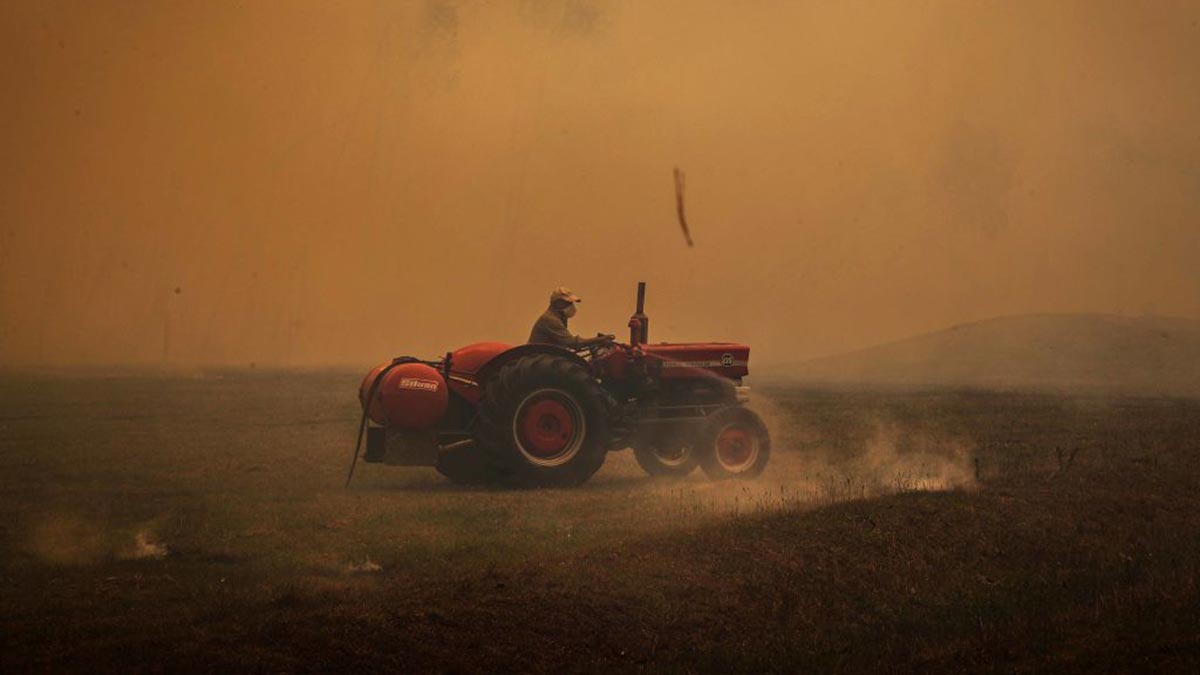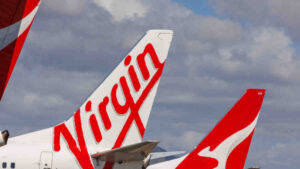These sectors bear the brunt of the bushfires

A farmer uses a hose to douse flames as he drives a tractor in a burning paddock in NSW. Pic: Getty
While heavy rainfall has brought the bushfires that ravaged large tracts of Australia under control, it has by no means extinguished them, with the New South Wales’ Rural Fire Service warning that the return of high temperatures could again elevate the fire risk.
The bushfires have already caused tremendous damage with more than 10 million hectares of land burned nationally, a billion animals killed, more than 2,000 homes destroyed and 29 people dead.
Already, the federal government has promised an extra $2 billion for a new national bushfire recovery agency to assist the rebuild of homes and critical infrastructure, while private donors have contributed millions towards relief efforts and longer term rebuilding.
Stockhead previously looked in detail at the economic impact of the bushfires, but investment bank UBS has now provided its estimates.
It reckons the bushfires could reduce Australia’s gross domestic product (GDP) by 0.25 per cent in both the fourth quarter of 2019 and the first quarter of 2020.
UBS expects stocks with exposure to the retail, insurance, food & beverage and transport sectors to be hit the hardest, while the resources, building materials and infrastructure sectors are likely to be only mildly affected.
Analyst Pieter Stoltz noted that while the bushfires had largely affected rural or regional areas, the indirect impacts of smoke haze and weaker overall consumer confidence had been felt in the largest cities such as Sydney and Melbourne.
Tourism could also be affected with the Australian Tourism Export Council estimating a reduction of between 10 and 20 per cent in international tourism revenue in 2020.
Additionally, lost work days and reduced spending are expected to put further pressure on the beleaguered retailed sector.
Insurance is another area that will see significant impact, with some industry estimates suggesting that the cost could be similar to the 2009 Black Saturday fires, which resulted in payouts totalling $2 billion in today’s dollars.
The Black Saturday fires in Victoria in 2009 killed 173 people and are estimated to have cost $4.4 billion.
Stocks in the line of fire
Fashion retailed Mosaic Brands (ASX:MOZ) flagged in mid-January that sales for the latter half of the December 2019 quarter – a crucial sales period for any retailer – would be impacted by about 8 per cent due to the bushfires.
Super Retail Group (ASX:SUL) said the bushfires had caused store disruptions and, along with sustained drought conditions, had resulted in declining sales for its BCF and Macpac outdoor brands.
On the food and beverage/agriculture front, Bega Cheese (ASX:BGA) said that while the bushfires had a significant impact on some farmers and employees, the direct impact on its overall milk supply and operations was minimal.
UBS said Treasury Wines Estates (ASX:TWE) may have suffered some damage to its vineyards, affecting yields.
Winemaker Australian Vintage (ASX:AVG) previously warned that its 30-hectare Charleston vineyard in the Adelaide Hills had been impacted, while estimating the fires may have wiped out a third of wine production in the Adelaide Hills.
UBS added that the transport sector would likely be affected by reduced tourist volumes.
The investment bank said that flight cancellations by international tourists, which account for about 20 per cent of passenger volumes, could be a negative for Sydney Airport (ASX:SYD).
NOW READ:
Putting a price tag on a bushfire: the cost and the stimulus
Australian fires take their toll on agriculture and mining
UNLOCK INSIGHTS
Discover the untold stories of emerging ASX stocks.
Daily news and expert analysis, it's free to subscribe.
By proceeding, you confirm you understand that we handle personal information in accordance with our Privacy Policy.








